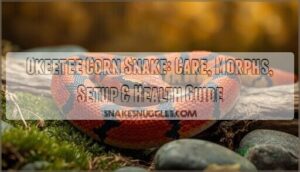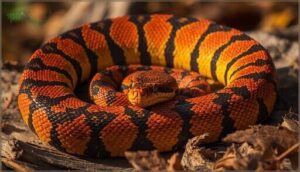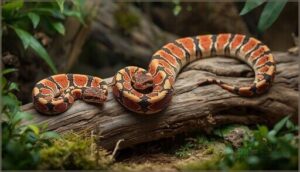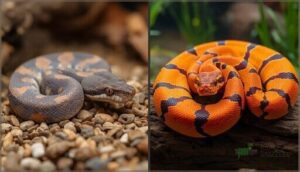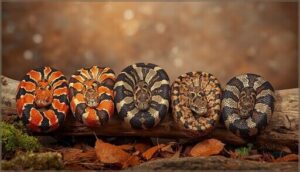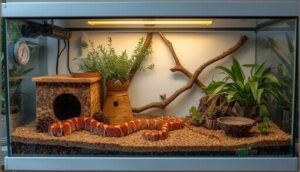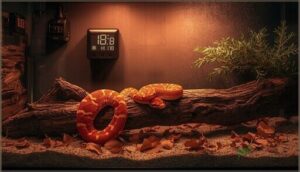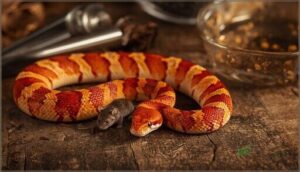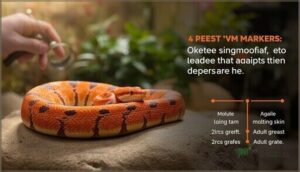This site is supported by our readers. We may earn a commission, at no cost to you, if you purchase through links.
If you’re drawn to snakes that look like they belong in a high-end reptile gallery, the okeetee corn snake might be exactly what you’re after. This morph features deep orange scales with bold red saddles outlined in thick black borders—a combination that turns heads at expos and makes first-time keepers feel like they’ve struck gold.
Unlike some morphs bred for novelty, Okeetees trace back to a specific wild population in South Carolina, giving them a natural intensity that captivates both beginners and longtime breeders.
Their vivid coloring doesn’t come with diva-level demands, either. You’ll find that caring for an okeetee corn snake follows the same straightforward approach as other corn snake varieties, with feeding schedules, habitat needs, and temperament that make them forgiving for newcomers while still rewarding experienced keepers with their stunning looks.
Table Of Contents
- Key Takeaways
- What is an Okeetee Corn Snake?
- Okeetee Corn Snake Physical Characteristics
- Okeetee Corn Snake Morph Variations
- Housing and Habitat Setup
- Temperature, Lighting, and Humidity Needs
- Diet, Feeding, and Handling
- Health, Lifespan, and Purchasing Tips
- Frequently Asked Questions (FAQs)
- What do Okeetee Corn Snakes Eat?
- What are the Different Morphs of Okeetee Corn Snakes?
- How Often Should Okeetee Corn Snakes Be Fed?
- Are Okeetee Corn Snakes Venomous?
- Can Okeetee corn snakes breed with other morphs?
- How often do Okeetee corn snakes shed?
- What size prey should I feed my Okeetee?
- Do Okeetee corn snakes need UVB lighting?
- Are Okeetee corn snakes good for beginners?
- Do Okeetee corn snakes hibernate in captivity?
- Conclusion
Key Takeaways
- Okeetee corn snakes feature deep orange scales with bold red saddles outlined in thick black borders, originating from a specific wild population in South Carolina’s Okeetee Hunt Club that was selectively bred for decades to enhance their striking high-contrast appearance.
- Despite their gallery-worthy looks, Okeetees follow the same straightforward care requirements as other corn snakes—including simple habitat setups, predictable feeding schedules of appropriately sized frozen-thawed mice, and docile temperaments that make them ideal for first-time reptile keepers.
- These snakes live 15–20 years in captivity with proper care (more than double their wild lifespan), growing from 8–12 inch hatchlings to 3.5–5 foot adults by age two, with most dramatic growth happening during their first year.
- Several morph variations exist beyond the classic Okeetee—including Abbotts Okeetee with even thicker borders and brighter colors, Tessera Okeetee with lateral stripes instead of saddles, and Reverse Okeetee featuring white borders on amelanistic backgrounds—with prices ranging from $70–250 depending on rarity and lineage.
What is an Okeetee Corn Snake?
If you’ve been searching for a beginner-friendly snake with show-stopping looks, you’re in the right place. The Okeetee corn snake isn’t just another morph—it’s one of the most vibrant and recognizable varieties out there, with deep orange scales and bold red saddles that catch your eye immediately.
Let’s break down what makes this morph special, where it comes from, and why it’s become such a staple in the reptile community.
Defining The Okeetee Morph
The Okeetee corn snake originated at South Carolina’s Okeetee Hunt Club, where breeders noticed wild snakes with exceptionally bold reds and thick black borders. Through selective breeding over generations, that striking look became a recognized phenotype.
Today, “Okeetee” describes both the original bloodline and any normal-type corn snake morph with those signature high-contrast visual criteria—thick saddle borders and vibrant orange ground color.
Unique Coloration and Patterns
What sets these snakes apart? You’ll see deep red saddle markings wrapped in thick, jet-black borders that run down the entire body—more than 90% of Okeetee morphs show this signature pattern. The bright orange ground color creates remarkable contrast, a result of decades of selective breeding.
Their ventral side displays a distinctive checkerboard pattern of alternating black and white marks. Each saddle blotch stays crisp from head to tail, with black edges averaging twice the thickness of other corn snake color variations.
Origins in South Carolina
That stunning pattern comes from a very specific place. The Okeetee Corn Snake origins trace back to the Okeetee Hunt Club in Jasper County, South Carolina, where collectors first noticed these vividly colored snakes in the 1950s–1970s. Early collection history shows they were prized specimens. The captive morph evolution began when breeders like Kathy Love used that Carolina geographic context stock to improve the look. Today, lineage preservation ensures Abbotts Okeetee lines maintain their roots. Corn snakes are now popular due to captive breeding efforts.
- Wild-caught from Jasper County through the mid-20th century
- Selectively bred by pioneers starting in the 1980s
- Distinguished from general corn snakes by locality
- Now mostly captive-bred descendants of original stock
Okeetee Corn Snake Physical Characteristics
One of the best things about Okeetee corn snakes is how striking they look—you’ll know one when you see it. Their bold coloring and unique markings set them apart from other corn snake morphs, and these features change as they grow.
Let’s break down what makes their appearance so distinctive at different life stages.
Saddle Markings and Coloration
What really catches your eye with these snakes is their striking saddle marks—deep red dorsal patterns framed by thick black borders at least one scale wide.
Through selective breeding, color inheritance brings orange ground coloration covering 70-80% of the body, while pattern variations show 18 to 24 distinct saddles.
Border thickness actually increases 20-30% across breeding generations, making each Okeetee corn snake appearance truly distinctive.
Size, Weight, and Growth Stages
Your Okeetee corn snake grows through several predictable stages, each with distinct size milestones:
- Hatchling size: New babies emerge at 10-15 inches and weigh just 6-8 grams.
- Growth rate: They’ll triple in length during year one, hitting 60+ centimeters.
- Adult size: Most reach 3.5-5 feet by age 2-3.
- Weight ranges: Adults generally weigh 1-2 pounds.
- Size variation: Individual snake lifespan factors influence final dimensions.
Hatchling Vs. Adult Appearance
The transformation from hatchling to adult is dramatic. Young Okeetee corn snakes emerge with dull gray-brown background hues and thin, patchy saddle borders.
By adulthood, color intensity explodes—orange ground color brightens noticeably, red saddles deepen, and black borders thicken into bold, continuous outlines. Post-shed sheen in adult snakes produces a “glowing” effect you rarely see in hatchlings, while belly patterns gain more pronounced contrast with age.
Okeetee Corn Snake Morph Variations
The Okeetee morph isn’t just one look—breeders have created several variations over the years, each with its own traits. Some stick close to the classic pattern, while others introduce wild twists like stripes or even scaleless skin.
Let’s break down the main types you’ll come across and what sets them apart from other corn snake morphs.
Classic Vs. Abbotts and Tessera Okeetees
You’ll notice real differences when you compare Okeetee Corn Snake morphs. Classic Okeetees show moderate border thickness around their saddles, while Abbotts Okeetee snakes push color intensity to the extreme with bold, thick black borders and bright orange ground.
Tessera Okeetee morphs flip the script entirely, replacing saddles with dorsal striping while keeping that signature Okeetee contrast.
Lineage rarity and pattern inheritance directly impact pricing factors across all three.
Genetic Traits and Inheritance
Okeetee Corn Snake genetics aren’t as simple as you might expect. These snakes rely on polygenic traits—dozens of genes working together—rather than a single genetic mutation.
Line-breeding effects strengthen those vivid saddles and thick borders, but genetic dilution kicks in fast when you cross them with non-Okeetee stock.
Trait heritability drops below 10% after just two outcrosses, proving morph interactions demand careful planning.
Okeetee Vs. Other Corn Snake Morphs
When you compare Okeetee Corn Snake Morphs to other Corn Snake Morphs, you’ll notice color differences right away. Miami-phase snakes show gray backgrounds, while Okeetee corn snake morph variations flaunt bright orange with bold black borders.
Pattern genetics vary too—Tessera types have stripes instead of saddles.
Market value shifts based on rarity, but temperament stays consistent across regional morphs and types of Okeetee Corn Snakes.
Housing and Habitat Setup
Getting your Okeetee’s home right from the start makes all the difference in their health and happiness. You don’t need anything fancy, but you do need to think about space, comfort, and safety.
Let’s break down the essentials so you can create a setup your snake will thrive in.
Minimum Enclosure Size
Your Okeetee corn snake needs room to stretch, turn, and explore comfortably. Tank size isn’t about guessing—it’s about matching their growth and ensuring long-term welfare. Here’s what you’ll want to take into account:
- Hatchlings: Start with a 10-gallon tank (about 50 × 25 × 30 cm) until they reach roughly 30 cm.
- Juveniles: Upgrade to a 20-gallon long tank as they grow toward 90 cm.
- Adults: Provide at least a 40-gallon enclosure, ideally 120 × 60 cm, for full-sized Okeetee corn snakes.
Floor space matters more than tank volume or vertical space, so prioritize length and width. Upgrade timing depends on their growth rate, but plan ahead—larger adults thrive in 75-gallon setups or bigger.
Modern regulatory standards emphasize that snake enclosure requirements should support natural behaviors, not just basic survival. Your snake habitat setup should allow your Okeetee to stretch its entire body along one wall, with room left over for enrichment.
Substrate Choices and Hides
Once your tank size is set, choosing the right substrate and hides becomes your next priority. Substrate impaction risk is real—avoid pine, fir, and fine sand that snakes can accidentally ingest. Instead, opt for aspen shavings, cypress mulch, or bioactive substrates like topsoil-coconut fiber blends. Lay at least 3–4 inches to support burrowing behavior and maintain 65–75% humidity.
| Substrate Type | Best For |
|---|---|
| Aspen shavings | Dry, simple snake habitat setup |
| Cypress mulch | Moderate humidity retention |
| Topsoil + coconut fiber + sand | Bioactive snake enclosure requirements |
| Coconut husk | Naturalistic snake habitat |
| Paper towels | Quarantine or medical observation |
Your snake enclosure needs at least two hides—one warm, one cool—so your Okeetee can thermoregulate without sacrificing security. Choose snug, opaque designs that fit your snake’s body width. Add a humid hide filled with moistened sphagnum moss on the cool side for shedding support. Proper hide placement across thermal zones reduces stress and mimics natural refuges like rodent burrows. Stack cork bark or foliage for extra cover if your habitat allows it.
Water, Décor, and Enrichment
Beyond hides, your Okeetee needs a water bowl large enough for full-body soaking—about 10–20% of your enclosure floor space. Place it on the cool side to keep humidity management in check, usually around 40–60%, and change water daily.
Add branches, elevated platforms, and clutter to boost enclosure complexity; research shows naturalistic décor drives better behavioral outcomes, encouraging climbing, exploration, and reduced stress in your Okeetee corn snake habitat.
Temperature, Lighting, and Humidity Needs
Getting your Okeetee’s environment just right means nailing three key factors: temperature, lighting, and humidity. These aren’t just nice-to-haves—they’re what keep your snake healthy, active, and able to shed properly.
Here’s what you need to know about each one.
Ideal Temperature Ranges
How do you keep your Okeetee healthy and active? The secret lies in temperature monitoring. Your Okeetee corn snake care demands a thermal gradient with a cool side around 75°F and a warm basking spot near 85°F. Snake enclosure requirements include allowing a nighttime drop to roughly 70°F.
Proper corn snake care aids digestion and prevents heat stress—two cornerstones of snake care success.
Lighting and Day/Night Cycle
After dialing in those temperatures, you’ll want to tackle photoperiod—the daily light–dark cycle that anchors snake behavior. Run white basking lights for 12 hours, then switch them off for total nighttime darkness.
Many keepers add low-intensity UVB to offer benefits like better calcium metabolism and natural basking.
Seasonal variation—shifting to 13 hours in summer, 11 in winter—can mirror the rhythms your Okeetee would experience in its South Carolina homeland, supporting healthy reptile rhythms year-round.
Humidity Levels and Shedding Support
Humidity is key to successful shedding—you’ll maintain 40-60% most days, then increase it to 60-70% when your Okeetee’s eyes turn cloudy. Add a humid hide packed with damp sphagnum moss so she can soak up extra moisture on her terms.
Low humidity below 40% invites stuck sheds and retained eye caps, so mist daily and check readings with a digital hygrometer.
Diet, Feeding, and Handling
Feeding your Okeetee corn snake the right food at the right time keeps them healthy and thriving for decades. You’ll need to adjust meal sizes and schedules as your snake grows from a hatchling into a full-sized adult.
Understanding their diet and how to handle them safely will make your experience as an owner much more rewarding.
Recommended Diet by Age
Your Okeetee Corn Snake’s diet shifts as it grows, just like kids graduate from baby food to solid meals. Hatchlings start with pinky mice weighing 1.5-2.5 grams, while juveniles move up to fuzzies and hoppers. Subadults handle small adult mice, and full-grown adults thrive on 20-30 gram feeders.
Here’s what to offer at each stage:
- Hatchlings (8-20″): Pinky mice, 1.5-2.5 grams
- Juveniles (20-45″): Fuzzy to weaned mice, 3-20 grams
- Subadults (35-50″): Small adult mice, 18-30 grams
- Adults (35″+): Adult mice or occasional young rats
- Seniors (18+ years): Smaller portions, adjusted frequency
Feeding Schedule and Portion Sizes
Feeding frequency matters more than most new owners realize. Hatchlings need pinky mice every 5-7 days, while juveniles shift to 7-10 day intervals with appropriately sized frozen feeders. Subadults thrive on 10-12 day schedules, and adults only require meals every 14-21 days. Senior snakes benefit from adjustments based on activity level.
Your snake’s body condition—not a rigid calendar—should guide your snake feeding routine.
Safe Handling and Temperament
Your Okeetee Corn Snake’s docile traits make handling a pleasure, not a gamble. Start with 1-2 weekly sessions after a two-week settling period, and you’ll notice their calm demeanor quickly.
Master these reptile handling tips for success:
- Timing matters: Skip handling for 48 hours post-feeding to prevent regurgitation
- Approach technique: Come from the side, supporting their full body length
- Watch stress indicators: S-shaped posture or hissing means back off
- Bite risk reality: Adult nips feel like pinches and heal fast
- Build trust gradually: Start with 5-10 minute sessions during the taming process
Health, Lifespan, and Purchasing Tips
Keeping your Okeetee healthy means knowing what to watch for and catching problems early.
With proper care, these snakes can be your companion for decades, so understanding their growth timeline and health needs is important.
Common Health Issues and Prevention
Like any pet, your Okeetee Corn Snake can face health bumps along the way. Respiratory infections, parasitic infections, digestive disorders, shedding problems, and nutritional deficiencies top the list of reptile health issues you’ll want to watch for.
Most animal health concerns stem from environmental missteps—wrong temps, humidity, or feeding schedules. Catching symptoms early and seeking veterinary care when needed keeps your snake thriving for decades.
Lifespan and Growth Expectations
You can expect your Okeetee Corn Snake to stick around for 15–20 years in captivity—far longer than the 6–8 years they’d see in the wild. Growth happens fast in that first year, slowing down once they hit maturity around age two.
In captivity, your Okeetee corn snake can live 15–20 years—more than twice its wild lifespan—with most growth happening in year one
- Hatchlings start at 8–12 inches and weigh just 6–8 grams
- By six months, they reach 20–30 inches and 26–30 grams
- Adult Okeetee Corn Snakes measure 3.5–5 feet and weigh 500–900 grams
- Ideal conditions—proper diet, temps, and low stress—boost both growth and snake lifespan
- Genetic influence can cause some variation in size and longevity
Morph Availability, Pricing, and Buying Advice
When you’re ready to buy, know that classic Okeetee morphs run $70–100, while rarer captive-bred varieties like High Pied can hit $200–250. Morph costs vary by genetics and breeder reputation.
Stick with trusted platforms—MorphMarket, XYZReptiles, and Big Apple Herp offer health guarantees and live arrival promises. Always confirm your snake’s feeding on frozen-thawed mice and choose captive-bred over wild-caught for better temperament.
Frequently Asked Questions (FAQs)
What do Okeetee Corn Snakes Eat?
Your Okeetee corn snake thrives on a pure carnivore diet—frozen-thawed mice are the go-to. Prey size should match 1-5 times their mid-body width, with feeding frequency adjusted as they grow.
What are the Different Morphs of Okeetee Corn Snakes?
Not all that glitters is gold, and not every corn snake with red saddles is a true Okeetee. Classic Okeetee corn snakes showcase thick black borders around deep red saddles on orange backgrounds—a signature look from South Carolina’s Okeetee Hunt Club locality.
You’ll find several popular Okeetee morphs worth knowing. Abbotts Okeetee takes things up a notch with even wider black borders and brighter orange-to-red saddle coloration, thanks to Lee Abbott’s selective breeding work. These specimens command higher prices, often around $100 to $200 for quality individuals.
The Tessera Okeetee combines the classic pattern with a genetic twist. This incomplete dominant mutation creates bold lateral stripes instead of traditional saddles. When you pair a Tessera with a non-Tessera parent, you’ll get roughly 50% Tessera offspring. Breeders sometimes sell clutches featuring Tessera combinations at $500 per group.
Reverse Okeetee is the amelanistic version, where black borders become striking white rings around red-orange centers. The background shifts to light yellow or orange, creating a high-contrast look that’s surprisingly different from the classic form. Some folks confuse these with striped variants early on.
Extreme Okeetee pushes the limits further—thicker borders and more vibrant saddles than standard lines. It’s a line-bred trait rather than a single-gene morph, so crossing with regular corn snakes dilutes those enhanced features. Breeders use Extreme Okeetee in hybrid projects for eye-catching combinations.
Each morph has its charm, but they all share that docile temperament and beginner-friendly care requirements that make Okeetee corn snakes so appealing.
How Often Should Okeetee Corn Snakes Be Fed?
Your snake’s age determines its snake feeding schedule. Hatchlings need meals every five to seven days, juveniles every seven to ten days, and adults thrive on a corn snake diet offered every fourteen to twenty-one days.
Are Okeetee Corn Snakes Venomous?
No, these snakes lack venom glands entirely. Bites may cause minor punctures and bleeding, but pose no toxin risk.
The real concern is infection from bacteria, so always clean wounds promptly.
Can Okeetee corn snakes breed with other morphs?
Yes, they can—Okeetee corn snakes breed freely with any other morph because they’re all the same species, Pantherophis guttatus.
Offspring show mixed traits, though pure Okeetee patterns often fade without selective breeding.
How often do Okeetee corn snakes shed?
Shedding frequency depends on age—hatchlings usually shed every 4 to 6 weeks during rapid growth, while adults usually shed roughly every 2 to 3 months once they’ve reached full size and stable weight.
What size prey should I feed my Okeetee?
Prey size rules for snake feeding guide reptile nutrition: hatchling prey should match 1–5 times your snake’s mid-body width.
Juvenile prey scales up to fuzzies or hoppers, while adult prey generally includes small adult mice—diet adjusting size as feeders grow.
Do Okeetee corn snakes need UVB lighting?
UVB isn’t strictly required—Okeetee corn snakes can survive without it—but providing UVB lighting promotes better vitamin D3 levels, skeletal health, and natural behaviors.
Many keepers report improved activity and appetite when UVB is included in the snake enclosure requirements.
Are Okeetee corn snakes good for beginners?
Corn snakes rank among the easiest pet snakes for first-time keepers. Their calm temperament, straightforward care level, moderate space requirements, and affordable cost make them ideal beginner reptiles—even when common mistakes occur.
Do Okeetee corn snakes hibernate in captivity?
No, Okeetee corn snakes don’t need brumation in captivity. You can keep stable temperatures year-round without health issues. Brumation primarily aids breeding but isn’t required for your pet’s wellbeing or longevity.
Conclusion
Beauty meets simplicity with the okeetee corn snake—a morph that delivers gallery-worthy looks without asking for expert-level care. You’ll spend less time worrying about finicky husbandry and more time enjoying those vivid orange scales and bold black-bordered saddles.
Whether you’re starting your first reptile journey or adding another stunner to your collection, this South Carolina native proves that striking appearance and beginner-friendly temperament can absolutely coexist.
Your setup stays straightforward, your snake stays healthy, and the visual payoff never gets old.

